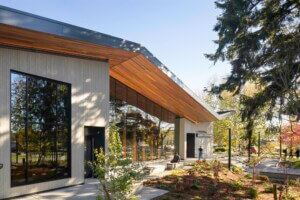A digitally-designed medical products showroom plays well with its City Beautiful neighbors.
The Global Center for Health Innovation, designed by LMN Architects along with the attached Cleveland Convention Center, is more than a showroom for medical products and services. Located adjacent to the Burnham Malls, the open space at the heart of Daniel Burnham’s Group Plan of 1903, the building is part of Cleveland’s civic core. “One of the things about the Global Center is that it has a unique expression and in particular the facade treatment,” said design partner Mark Reddington. “But it’s also a really integrated piece of a bigger idea and a bigger composition.” A dynamic combination of textured concrete panels and irregular slashes of glazing, the Global Center’s facade, which won honorable mention in AN’s 2014 Best of Design Awards, deftly negotiates the gap between the building’s historic context and its function as a high-tech marketplace.
The Global Center’s City Beautiful surrounds influenced its facade design in several ways. “Part of the trick for us in looking at the Global Center,” said project architect Stephen Van Dyck, “was to try and make a building that was contemporary and relevant, but also a building that referred and deferred to its context materially and compositionally.” As a reflection on the solidity of the older structures ringing the Malls, the architects minimized glazing in the east face’s concrete system. In addition, they chose the color and aggregates of the concrete to mimic the tone of limestone. The texturing on the concrete panels, too, was informed by the Global Center’s context. “Like the classical buildings, there’s a lot of detail that shows up in different lighting conditions,” said Reddington. At the same time, the Global Center is very much a product of the 21st century. “There was an explicit intention in creating a facade whose qualities would not have been achievable without digital technology,” said Van Dyck. “It doesn’t look like it was handcrafted. It was primarily an exercise in allowing the technical means of creation and design to live forever on the outside of this building.” In particular, he said, the architects were interested in how their chosen material—precast concrete—allowed them to move beyond a punched-window system to a more complicated relationship between solids and voids. The result eventually became a scientific metaphor, as the designers observed the resemblance of the pattern to the twisting helices of a DNA molecule.
LMN developed the facade design on a remarkably short timeline: about four months from concept to shop drawings. “The schedule requirements of the whole thing were absurd,” said Van Dyck. To make modifying the design as easy as possible, the architects developed a utility called Cricket to link Grasshopper and Revit. The ability to update the BIM model in real time convinced the design-build team to take risks despite the compressed timeframe. “Once they realized there was a strong mastery of the data, an ability to listen and incorporate the needs of [multiple] parties, that was really the breakthrough,” explained Van Dyck. “They said, ‘Hey, we can build something that’s a little unconventional.’”
- Facade Manufacturer Sidley Precast Group, NUPRESS Group
- Architects LMN Architects
- Facade Consultant Facade Forensics
- Facade Installer Harmon
- Location Cleveland, OH
- Date of Completion June 2013
- System Precast concrete panels and glazing welded to vertical steel tubes, structural glass wall
- Products Precast concrete panels by Sidley Precast Group, Viracon VU1-40 (glazing), Viracon VE1-2M (atrium wall)
Besides their Cricket plug-in, a 3D printer was LMN’s most valuable tool during the design process. To explore how the panels’ texturing would animate the facade under different lighting conditions, they created plaster models from 3D-printed casts. “We had to do that because the geometry was so complex that we didn’t have any computers at the time that were capable of [modeling it],” said Van Dyck. “For us, working between the physical, digital, hand-drawn renderings were all so critical in discovering what we ultimately ended up building.” Sidley Precast Group fabricated the concrete panels with a surface pattern of horizontal joints that vary in depth and height. To minimize cost, the fabricators made almost all of the molds from a single 8-by-10-foot master formliner, with horizontal ribs spaced every 6 inches acting as dams for the smaller molds. While LMN Architects originally wanted to limit the number of panel types to eight, the final count was around 50, including larger pieces made by connecting smaller panels vertically. The approximately 400 precast panels were moved by crane to a system of vertical steel tubes running from slab to slab, then welded into place. The Viracon glazing was welded to the same tubes, a couple of inches back from the face of the concrete. The large atrium window on the building’s east face was manufactured by NUPRESS Group. For the architects, the significance of the Global Center’s facade remains tied to its broader context. Its design, while driven by modern technology, achieves a surprising degree of harmony with its surroundings. “Our building is in a way very classical, though it wasn’t an explicit intention of ours,” said Van Dyck. “To create a language that was both universal and also something that was really new—from our perspective that was a big achievement of the project.”










